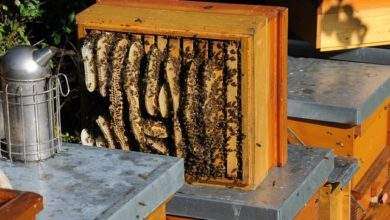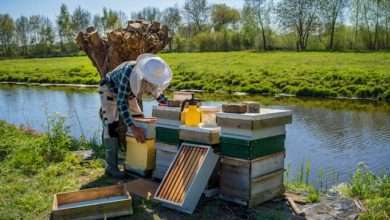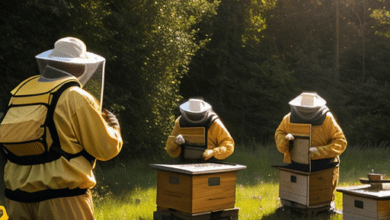Beekeeping Calendar: A Guide to Year-Round Beekeeping

Beekeeping requires dedication and attention throughout the year, and a beekeeper’s calendar can help to keep operations running smoothly.
This article will cover the key tasks and activities that beekeepers should focus on during each season, from hive inspections to honey extraction to winter preparation. By following a structured schedule, beekeepers can ensure the health and productivity of their hives and maximize their success in the apiary.
The Importance of Beekeeping Calendar
In the world of beekeeping, timing is everything. Successful beekeepers understand the significance of precision in their actions and the delicate balance of nature. One essential tool that every beekeeper should have in their arsenal is a beekeeping calendar.
Significance of Proper Timing
Beekeeping is a highly seasonal endeavor, and the lives of honeybees are closely intertwined with the natural cycles of the environment. To effectively manage and support honeybee colonies, it is crucial for beekeepers to synchronize their efforts with these cycles.
Whether it’s hive inspections, honey harvesting, or pest control measures, understanding when and why these tasks should be completed will greatly impact the overall health and productivity of bees.
Benefits of Following a Beekeeper’s Calendar
By adhering to a carefully planned beekeeping calendar, beekeepers can experience several significant benefits:
- Increased hive productivity: Proper timing of tasks such as hive inspections, swarm prevention, and feeding enables beekeepers to maximize honey production and overall hive productivity.
- Enhanced colony health: Regular monitoring and proactive pest control measures help to prevent the spread of diseases and ensure the well-being of honeybee colonies. This ultimately leads to stronger and more resilient bees.
- Time management and efficiency: A well-structured calendar ensures that beekeepers stay organized and focused on essential tasks, reducing the likelihood of overlooking key activities. This allows for effective time management and increased efficiency in beekeeping operations.
A beekeeping calendar is an indispensable tool for any beekeeper aiming for success. By understanding the significance of proper timing, including essential tasks in the calendar, and reaping the benefits of following a beekeeper’s calendar, beekeepers can create a harmonious relationship with their honeybees and optimize their beekeeping endeavors.
Spring Season
Spring is a crucial time for beekeepers as it sets the stage for the upcoming honey season. With the days growing longer and flowers blooming, bees become more active and require careful attention and management.
Hive Inspection and Maintenance:
During the spring, it is essential to conduct regular hive inspections to assess the overall health and condition of the colony. Inspections should focus on the following aspects:
- Brood Health: Check for the presence of brood patterns, looking for signs of diseases or abnormalities. Ensure a healthy brood population to ensure a strong colony.
- Queen Performance: Evaluate the performance of the queen by observing her laying pattern and the presence of eggs. A consistently laying queen is vital for colony growth and productivity.
- Pollen and Nectar Stores: Assess the availability of pollen and nectar stores within the hive. Bees require a sufficient food supply to support brood rearing and honey production.
- Pest and Disease Management: Monitor for signs of pests, such as Varroa mites, and take appropriate measures for control. Address any signs of diseases promptly to prevent their spread.

Feeding and Nutrition:
Spring is a critical period when bees must build up their strength and replenish their food stores. Consider the following feeding and nutrition practices during the spring season:
- Stimulative Feeding: If necessary, provide additional food sources such as sugar syrup or pollen substitute to supplement the natural forage. This stimulates colony growth and ensures bees have access to vital nutrients.
- Pollen Patties: Offer protein-rich pollen patties to enhance brood production. Pollen is an essential component for raising healthy larvae and developing strong bees.
Swarm Prevention:
As colonies build up their population and resources in the spring, the risk of swarming increases. Preventing swarming is essential to maintain strong, productive colonies. Consider the following measures to prevent swarming:
- Supering: Add supers or additional hive boxes to provide ample space for expanding populations. Bees tend to swarm when they feel cramped or overcrowded.
- Brood Manipulation: Inspect hives for signs of swarm cells and remove them promptly. If necessary, conduct a split, creating a new colony to alleviate crowding and prevent swarming.
Queen Rearing and Introduction:
Spring is an opportune time for queen rearing and introducing new queens into the colony. Here are some considerations for successful queen rearing:
- Queen Cell Production: Follow appropriate techniques to produce queen cells, whether through grafting or using queen cups. Maintain optimal conditions for queen rearing to ensure high-quality queens.
- Queen Introduction: Carefully introduce newly emerged queens into the hive, following proper techniques like using queen cages or the newspaper method. This allows for a smooth integration and acceptance by the existing colony.
Equipment Preparation:
Spring offers a window of opportunity to ensure your equipment is in excellent condition for the busy season ahead. Some key steps for equipment preparation include:
- Hive Cleaning: Clean and sanitize the hive components, such as frames, supers, and bottom boards, to remove any debris or potential disease pathogens.
- Replacement of Old Equipment: Evaluate the condition of equipment and replace any worn-out or damaged components. Ensure hive boxes, frames, and foundation are in good condition to provide a suitable environment for the bees.
By diligently following these springtime beekeeping activities, you can set the stage for a thriving colony and maximize the honey production potential. Remember to adapt your practices based on local climate and conditions to best support your bees.
Summer Season
As we dive into the summer season, it is essential to focus on various aspects of beekeeping that can contribute to the success and health of our hives.
- Honey Extraction and Processing:
Summer is an opportune time for beekeepers to reap the sweet rewards of their buzzing colonies’ hard work throughout spring. Honey extraction not only offers a chance to taste nature’s golden nectar but is also crucial for maintaining space within the hive.
Implementing proper honey extraction and processing techniques ensures that both bees and beekeepers can enjoy the fruits of their labor. By using honey extraction tools such as uncapping knives, extractors, and filters, beekeepers can carefully extract and collect honey without harming the bees or their delicate comb structure.
- Pest and Disease Management:
The summer season also presents an ideal environment for pests and diseases that can potentially harm our honeybee colonies. To safeguard our buzzing friends, it is vital to remain vigilant in pest and disease management.
Regularly inspecting hives for signs of common pests like varroa mites, wax moths, and small hive beetles can help catch infestations early and take appropriate action.
Additionally, staying informed about prevalent diseases such as American foulbrood or chalkbrood and implementing preventative measures can help maintain healthy colonies.
- Splitting Hives:
As bee populations flourish during summer, hives can quickly become crowded, potentially leading to swarming behavior or decreased honey production. To prevent such issues, beekeepers often employ a technique known as splitting hives.
Splitting involves creating new colonies by separating a portion of bees, brood, and resources from an existing hive. This method not only helps manage population density but also acts as a means of hive expansion and potential queen rearing.
By carefully executing hive splits, beekeepers can ensure the overall strength and productivity of their colonies.
- Supplemental Feeding:
During the summer season, certain circumstances like droughts or scarcity of nectar-rich flowers can disrupt a honeybee colony’s food availability. In such cases, beekeepers may engage in supplemental feeding to provide the necessary nutrition for their bees.
Creating a sugar syrup mixture, typically made from a combination of water and granulated sugar, can serve as a substitute for natural sources of sustenance. Beekeepers must ensure that they understand the correct ratios and feeding techniques to avoid any negative consequences on the hive.
- Hive Ventilation:
A well-ventilated hive is essential for the overall health and survival of honeybee colonies during the summer. With rising temperatures, bees utilize various strategies to regulate the hive’s internal atmosphere. Beekeepers can aid this process by providing proper hive ventilation through the use of screened bottom boards, top ventilation, or additional entrance holes.
Adequate airflow helps control humidity levels, prevent moisture-related issues like mold and dampness, and improve the overall well-being of the colony.
As the summer season sets in, beekeepers must adopt a proactive approach in maintaining their hives and ensuring the prosperity of their honeybee colonies. So don your protective beekeeping gear, grab your tools, and get ready to tend to your buzzing companions during this sunny stage of the year!
Fall Season
As the vibrant colors of summer gradually fade and transition into the cool embrace of autumn, beekeepers find themselves preparing their hives for the upcoming winter. The fall season is a crucial time for beekeepers to ensure the survival and well-being of their buzzing colonies.
- Winter Preparation: One of the key responsibilities of beekeepers in the fall is to prepare their hives for the harsh winter months ahead. This involves taking various measures to safeguard the bees against the chilly temperatures and limited food sources.
- Hive Insulation: Insulating the hive is essential in preserving warmth and reducing heat loss during the winter. By adding insulation materials to the outer walls and roof of the hive, beekeepers can help regulate the internal temperature and protect the bees from extreme cold.
- Varroa Mite Treatment: The fall season presents an opportune time for beekeepers to address the persistent issue of Varroa mites. These tiny parasites can wreak havoc on honey bee colonies if left unchecked. Implementing an effective treatment plan in the fall helps minimize mite populations, ensuring healthier bees and higher chances of winter survival.
- Honey Storage: Honey serves as a vital food source for bees during the wintertime when foraging opportunities become scarce. Beekeepers should assess the amount of honey stored within the hive and determine if supplementary feeding is necessary. Ensuring an ample supply of honey will enable the bees to sustain themselves until the arrival of spring.
- Colony Assessment: Conducting a thorough assessment of the colony’s condition is another crucial task during the fall season. Beekeepers should meticulously inspect the brood chambers, frames, and overall population of the hive. This assessment allows for early detection of any potential issues, such as diseases, insufficient food stores, or weak colonies, which can be rectified before winter sets in.
By diligently addressing these important tasks in the fall, beekeepers can significantly increase the chances of their honey bee colonies thriving through the winter and emerging strong in the following spring.
Winter Season
During the winter season, beekeepers must prioritize various tasks to ensure the well-being and success of their colonies. This chapter focuses on key activities that should be undertaken during this period to maintain healthy hives, plan for the upcoming year, and enhance your beekeeping skills.
Hive Maintenance: Winter is a crucial time to ensure the structural integrity of your hives. Take this opportunity to inspect the condition of your beehives, paying special attention to the following areas:
- Check for any signs of damage or wear on hive components, particularly the roof, frames, and entrance reducers.
- Insulate the hives if necessary, especially in colder regions, to provide the bees with extra protection against harsh weather conditions.
- Remove debris or dead bees accumulated at the bottom of the hives, allowing proper ventilation and reducing the risk of pests and diseases.
Equipment Storage: Properly storing your beekeeping equipment during the winter is vital to prolong its lifespan and maintain hygiene. Consider the following steps:
- Clean and sanitize all equipment, such as hive tools, brushes, and smokers.
- Store equipment in a dry and secure place to prevent moisture or pests from damaging them.
- If necessary, repair or replace any damaged equipment before the start of the new beekeeping season.
Monitoring Honey Stores: Bees rely on sufficient honey stores to survive the winter months when forage is scarce. Regularly check the honey levels within the hives to ensure the bees have an ample food supply:
- Gently lift each hive to gauge its weight. Heavier hives indicate an adequate honey reserve, while lighter ones suggest the need for supplementary feeding.
- If necessary, provide emergency winter feeding by placing fondant or sugar patties directly above the bees’ cluster to sustain them until spring blossoms become available.
- Consider using an infrared camera or a stethoscope to monitor the warmth and activity within the hive, enabling you to evaluate their overall health.
Planning for the Upcoming Year: Winter offers an ideal opportunity to strategize and plan for the forthcoming beekeeping season. Consider the following aspects when envisioning your goals for the upcoming year:

- Establish a comprehensive beekeeping calendar outlining important milestones, such as hive inspections, swarm prevention techniques, and honey harvesting.
- Research and select suitable bee breeds or hybrids for your specific region, taking into account their adaptability, productivity, and resistance to diseases.
- Evaluate the results of the previous year and identify areas for improvement, such as hive management techniques or pest control strategies.
Continuing Education and Research: Beekeeping is a dynamic and ever-evolving field, and winter presents an excellent chance to enhance your knowledge and skills. Engage in the following activities to stay informed and up-to-date:
- Attend beekeeping conferences, workshops, or seminars to learn from experienced beekeepers and researchers.
- Start a Beekeeping Journal to organize and record all you activities and observations while beekeeping.
- Read books, scientific articles, or online resources to broaden your understanding of various beekeeping topics, including hive health, new technologies, or emerging trends.
- Join a local bee club or online beekeeping communities to exchange ideas, seek advice, and stay connected with fellow beekeepers.
Remember, adopting a systematic and proactive approach to winter beekeeping tasks is crucial for the prosperity and vitality of your colonies.
FAQ:
Why is a beekeeper’s calendar important?
- A beekeeper’s calendar is important because it provides a structured schedule for beekeepers to follow throughout the year, helping them stay organized and focused on key tasks and activities for each season.
What are the key tasks for beekeepers in the spring?
- In the spring, beekeepers should focus on hive inspection and maintenance, feeding and nutrition, swarm prevention, queen rearing and introduction, and equipment preparation.
How can the Beekeeping Calendar benefit beekeepers?
- This calendar acts as a valuable resource, offering beekeepers a month-by-month account of recommended tasks, tips, and insights. It helps beekeepers plan and prioritize their activities to ensure healthy and thriving honeybee colonies.




